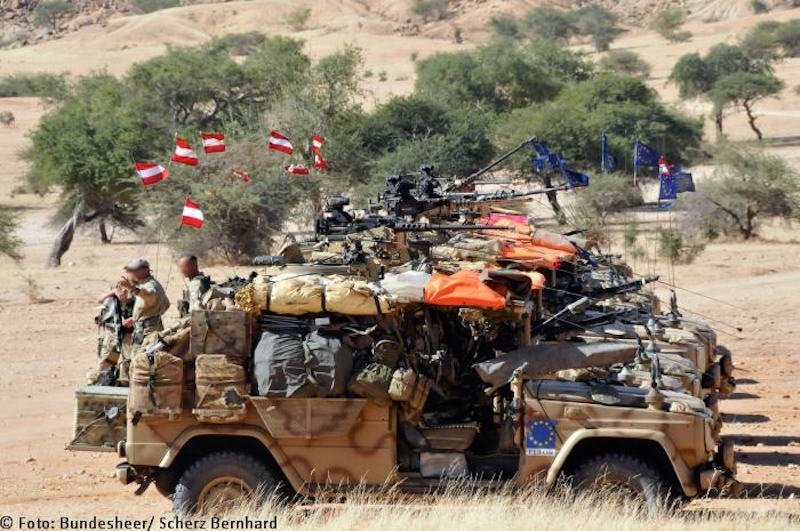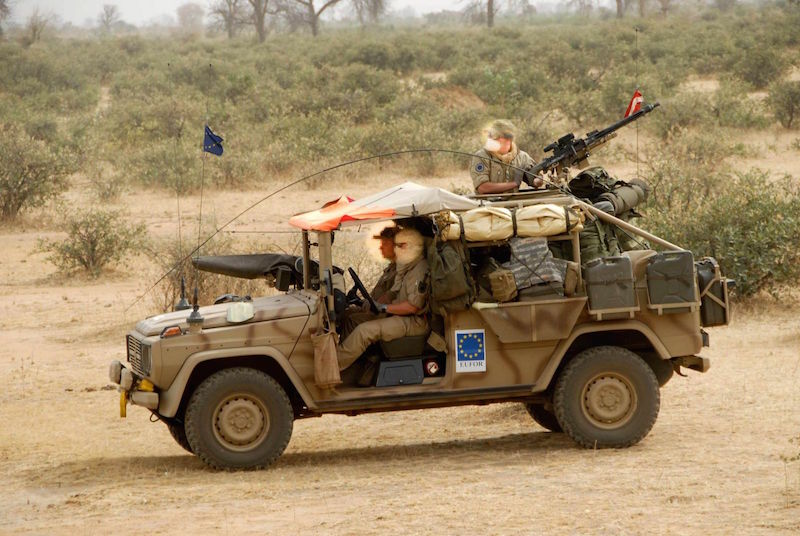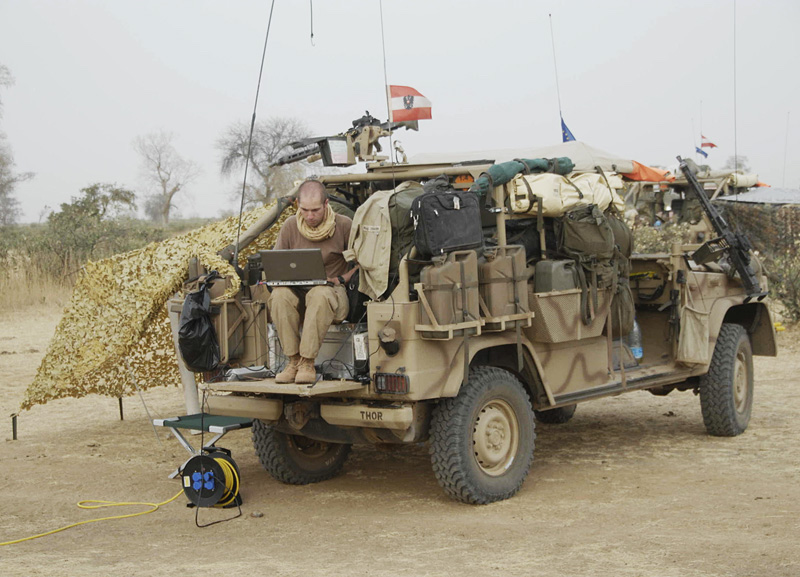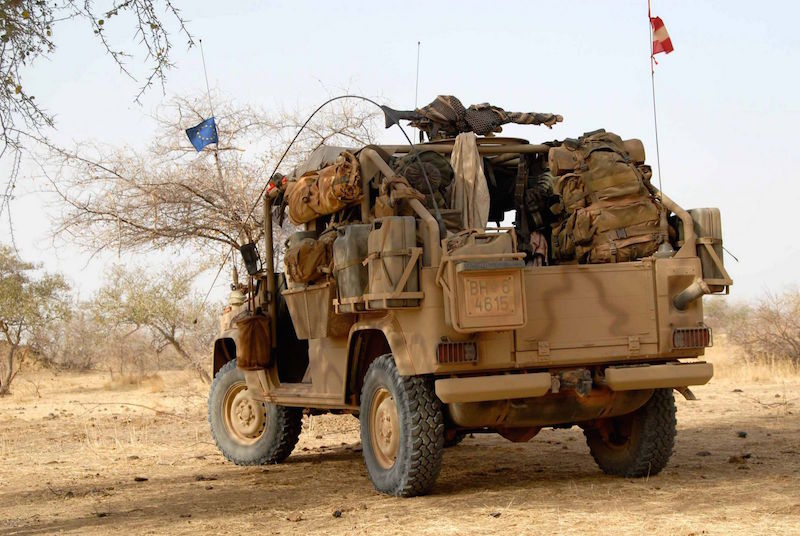Get the weekly SPARTANAT newsletter.
Your bonus: the free E-Book from SPARTANAT.

The sand viper in action
Pumas, leopards, and panthers (if not in the basement) proudly roam the plains. The sand viper, on the other hand, lies on the ground and can have a mean bite. – Animal names have a long tradition in the German-speaking area when it comes to naming military vehicles. SPARTANAT author Udo Lücken has taken a close look at the "Sandviper," the operational vehicle of the Austrian Jagdkommando, and its history.
With the "Sandviper," a troop vehicle specially tailored for missions in dry steppe and desert regions was acquired. Due to an immediate need, the project was processed by the Office for Armament and Defense Technology in record time from the requirements description, through the conversion planning, to operational readiness and in close cooperation with the special forces. The result is impressive: the vehicle, based on the proven Puch G 290 GD off-road vehicle of Steyr Daimler Puch AG, is called Puch G 290/LP Special Operations Vehicle "Sandviper."
 Deployment in Africa
Deployment in Africa
The participation of a contingent of the Austrian Jagdkommando in the EU mission EUFOR Tchad/RCA in Central Africa, in the area of Chad in 2007, was also the "baptism of fire" for this small, highly mobile, and heavily armed vehicle. The "Sandviper" is specially designed to meet the requirements of special forces. It is primarily intended for use as a patrol vehicle and fast attack vehicle for Jagdkommando soldiers.
The engineers of the development group determined the following parameters:
- • High autonomous deployability (large fuel and drinking water capacity)
• Large freedom of movement for the crew in the vehicle
• Strong off-road mobility and sufficient fording capability
• Adaptation of equipment to African climate conditions
• Powerful self-recovery equipment
• Weapon stations for carrying powerful machine guns
• High endurance and survivability for the crew
• Highest standard for radio and navigation electronics
• Long-term vehicle lifespan due to high-quality materials and processing
• High level of mounting and attachment options for additional equipment
The performance characteristics of this "Light Reconnaissance Vehicle" are defined by the intended uses.
With a length of 4.6 meters, a width (with storage compartments) of 2.09 meters, and a height (with gun mount) of 2.3 meters, the "Sandviper" has a small, inconspicuous, and rather flat silhouette. The 95 hp (70 kW) strong Steyr 5-cylinder 4-stroke diesel in-line engine accelerates the base vehicle (empty weight: 2,280 kilograms) on the road up to 130 kilometers per hour at 4,000 rpm. With a tank capacity (without reserve tanks) of 95 liters, an operational radius of up to 630 kilometers is possible. Despite a reinforced axle stub, the allowable payload weight is 3,150 kilograms, but it is often exceeded in operation. The three-soldier vehicle crew consists of a driver, a passenger (team leader and navigator), and a gunner/security personnel. With its engaged all-wheel drive, the Puch has a remarkable climbing capability of 70 percent and a fording depth of 50 centimeters.
 Protection against rockfall
Protection against rockfall
The driver is effectively protected against rockfall by a foldable Lexan windshield. This makes the "Sandviper" well-adapted to the operating conditions in challenging regions like Afghanistan and Central Africa.
To give the soldiers of the Jagdkommando more freedom of movement in the vehicles, the side and rear doors, as well as the rear seat, have been omitted. At the same time, this saves weight, benefiting the payload capacity. The entire tarpaulin roof structure has been replaced by the gunner's seat (folding seat system of the "ULAN") and the gun mount. What may seem puristic at first glance is a well-thought-out and practical design upon closer inspection. Attachments that did not serve the new operational system were removed and replaced with other modules. In the rear, a power inverter and compressor are securely mounted for the supply of additional units. The valuable operational experiences of the Jagdkommando have been fully incorporated into the vehicle. For example, there is a switch that switches the entire visible radiation of the vehicle electrics to a camouflage mode during combat operations. The vehicle then illuminates the area in front with its two infrared spotlights, while the driver observes the surroundings through the night vision goggles LUCIE.
For driving in desert regions, rugged "Goodrich Mud Terrain" tires are used. These are filled with the synthetic sealant "Air Seal" and allow the vehicle to continue running for up to 80 kilometers even with large caliber punctures. For self-recovery of the vehicle, the crew has access to highly tear-resistant recovery loops, air landing plates, special sand shovels, and a jack for sandy terrain. Communication places a high value on modern radios (TFF 1-0) and intercom systems (VIC-3) due to the often large distances.
 Self-defense and attack
Self-defense and attack
For self-defense as well as attack, the "Sandviper" is equipped with two MG 74 (MG 3 from Rheinmetall) in caliber 7.62 x 51 mm. The nearly twelve-kilogram MG fires full metal jacket rounds up to 3,750 meters with a throttled cadence of 850 rounds/min. The first MG 74 is mounted in front of the right team leader on a flexible and swiveling mounting in the direction of travel. It is detachable and can be used as a squad weapon without modification. The second weapon is locked in the swivel mount (from the tank destroyer "Jaguar") behind the driver. It can swivel 360 degrees and is operated by the gunner. The weapon is constantly loaded with 250 rounds in the side-mounted ammunition box.
Overall, over 2,000 rounds of ammunition per vehicle are stored in storage compartments, providing the vehicle with significant firepower. The sights of the MG 74 have been enhanced by an "Aimpoint" reflex sight and a laser light module for combat enhancement. An additional infrared laser on the weapon and the integration of the LUCIE goggles make the Puch "Sandviper" fully capable of night combat.
At the suggestion of the Jagdkommando soldiers, the heavy MG M2 in caliber 12.7 mm can be mounted on the sturdier mount of the armored personnel carrier A1 "Saurer" on the "Sandviper" instead of a second MG 74. This 38-kilogram machine gun is intended to engage targets beyond the 1,000-meter range or light-armored targets. This weapon also swivels 360 degrees on its mount. The vehicle carries 500 rounds in 100-round boxes for this weapon. The vehicle version with two MG 74 is referred to as "Sandviper I," while the one with one MG 74 and the heavy M2 is called "Sandviper II." There is also consideration of equipping with a potent 40 mm grenade machine gun.
Air Transportable
Due to its dimensions, the Puch "Sandviper" can be easily air-transportable in a C-130 Hercules, a C-160 Transall, or even as an external load under an S-70A "Black Hawk." This allows for rapid relocation to respond to unexpected, changing, or escalating situations in the operational areas. With success:
The Puch "Sandviper" proved to be a real "workhorse" in the demanding operations of the Jagdkommando. The concept's accuracy has been repeatedly demonstrated.
Photos: BMLV
SPARTANAT is the online magazine for Military News, Tactical Life, Gear & Reviews.
Send us your news: [email protected]
Ad
similar
Get the weekly SPARTANAT newsletter.
Your bonus: the free E-Book from SPARTANAT.



